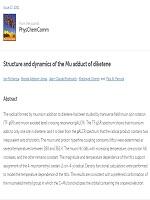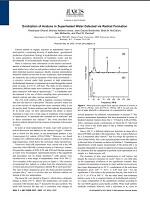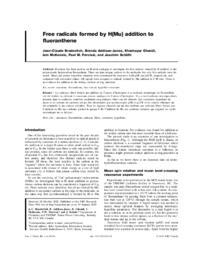McKenzie, Iain
Person Preferred Name
Iain McKenzie
Related Works
Content type
Digital Document
Abstract
Muoniated free radicals have been detected in muon-irradiated aqueous solutions at high temperatures and pressures. Results are presented for the cyclohexadienyl radical, formed by muonium addition to benzene, and for tert-butyl, formed by reaction of muonium with isobutene, itself formed in situ from the dehydration of the starting material, tert-butanol. This is the first report of the direct identification of organic free radicals in near critical and supercritical water.
Origin Information
Content type
Digital Document
Abstract
The radical formed by muonium addition to diketene has been studied by transverse field muon spin rotation (TF-[small micro]SR) and muon avoided level-crossing resonance ([small micro]ALCR). The TF-[small micro]SR spectrum shows that muonium adds to only one site in diketene, and it is clear from the [small micro]ALCR spectrum that the radical product contains two inequivalent sets of protons. The muon and proton hyperfine coupling constants (hfcs) were determined at several temperatures between 280 and 362 K. The muon hfc falls with increasing temperature, one proton hfc increases, and the other remains constant. The magnitude and temperature dependence of the hfcs support assignment of the 4-muonomethyl-oxetan-2-on-4-yl radical. Density functional calculations were performed to model the temperature dependence of the hfcs. The results are consistent with a preferred conformation of the muoniated methyl group in which the C-Mu bond eclipses the orbital containing the unpaired electron.
Origin Information
Content type
Digital Document
Abstract
Muonium is long-lived in pure water and has been studied over a very wide range of temperatures and pressures, from 5°C to over 400°C and from 1 to 400bar. We have determined rate constants for representative reactions of muonium in aqueous solution; equivalent data on H atom kinetics is sparse and stops well short of the maximum temperature and pressure attained in our experiments. The results show remarkable deviations from the predictions of standard reaction theories. In particular, rate constants pass through a maximum with temperature well below the critical point. This seems to be a general phenomenon, since we have observed it for spin-exchange and chemical reactions that are diffusion limited at low temperatures, as well as for activated reactions. We believe that a key factor in the drop of rate constants at high temperature is the cage effect, in particular the number of collisions between a pair of reactants over the duration of their encounter. Whatever the reason, the implications are profound for both the efficiency of supercritical water oxidation reactors and for the modelling of radiation chemistry in pressurized water nuclear reactors.
Origin Information
Content type
Digital Document
Abstract
Muoniated free radicals have been detected in muon-irradiated aqueous solutions of acetone at high temperatures and pressures. At temperatures below 250 °C, the radical product is consistent with muonium addition to the keto form of acetone. However, at higher temperatures, a different radical was detected, which is attributed to muonium addition to the enol form. Muon hyperfine coupling constants have been determined for both radicals over a wide range of temperatures, significantly extending the range of conditions under which these radicals and the keto−enol equilibrium have been studied.
Origin Information
Content type
Digital Document
Abstract
Muonium has been used as an H atom analogue to investigate the free radicals formed by H addition to the polyaromatic hydrocarbon fluoranthene. There are nine unique carbons in the molecule, but only five radicals were detected. Muon and proton hyperfine constants were determined by transverse field µSR and µLCR, respectively, and compared with calculated values. All signals were assigned to radicals formed by Mu addition to C-H sites. There isno evidence for addition to the tertiary carbons at ring junctions.
Origin Information
Content type
Digital Document
Abstract
Rate constants are reported for near-diffusion-controlled reactions of muonium in sub- and supercritical water. Specifically, the spin-exchange interaction of muonium with Ni2 + and the addition of muonium to hydroquinone were studied as a function of temperature and pressure over a wide range of conditions, from standard to over 400 °C and 400 bar (the critical point of water is at 374 °C, 220 bar). At elevated temperatures the rate constants were found to have values far below those predicted by Stokes–Einstein–Smoluchowski theory. Furthermore, the temperature variation of the isobaric rate constants has a maximum in the subcritical region. The pressure dependence of the rate constants increases with temperature, consistent with the increase in compressibility of the solvent; the effective activation volumes are negative. Various models are explored to interpret the temperature and density dependence of the kinetic data. It is concluded that a key factor in the drop of rate constants at high temperature is the cage effect, in particular the number of collisions between a pair of reactants over the duration of their encounter.
Origin Information
Content type
Digital Document
Abstract
The reaction of H atoms with fullerene C70 has been investigated by identifying the radical products formed by addition of the atom muonium (Mu) to the fullerene in solution. Four of the five possible radical isomers of C70Mu were detected by avoided level-crossing resonance (μLCR) spectroscopy, using a dilute solution of enriched 13C70 in decalin. DFT calculations were used to predict muon and 13C isotropic hyperfine constants as an aid to assigning the observed μLCR signals. Computational methods were benchmarked against previously published experimental data for 13C60Mu in solution. Analysis of the μLCR spectrum resulted in the first experimental determination of 13C hyperfine constants in either C70Mu or C70H. The large number of values confirms predictions that the four radical isomers have extended distributions of unpaired electron spin.
Origin Information







